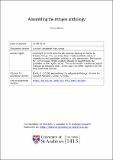Assembling the refugee anthology
Abstract
There has been a sudden proliferation of short story anthologies published in response to the refugee ‘crisis’ of 2015 and the US travel ban of 2017. This article focuses on two of these collections (The Displaced and Banthology, both 2018) in order to ask: what makes an anthology better equipped than a single authored piece of writing to respond to contemporary themes such as migration and displacement? The answer might lie in their heterogeneous form, which allows anthologies to be assembled and reassembled by various stakeholders during their production and reception so that they mean differently in different times and places. Conceiving of the anthology as assemblage brings Deleuze and Guattari’s original concept into dialogue with newer notions of queer curation and postcolonial reading, and reveals anthologising processes of selecting and fitting elements together to be deliberate tactics. In particular, these processes highlight the agentic role of the reader, which allows them to make their own assemblages from the multiple interrelations that emerge between the anthology’s composite elements. Through developing this concept of assemblage reading I extend the framework of what we think of as a ‘refugee anthology’ to encompass a much wider range of acts of collective creation.
Citation
Bond , E 2019 , ' Assembling the refugee anthology ' , Journal for Cultural Research , vol. Latest Articles . https://doi.org/10.1080/14797585.2019.1665894
Publication
Journal for Cultural Research
Status
Peer reviewed
ISSN
1479-7585Type
Journal article
Collections
Items in the St Andrews Research Repository are protected by copyright, with all rights reserved, unless otherwise indicated.

